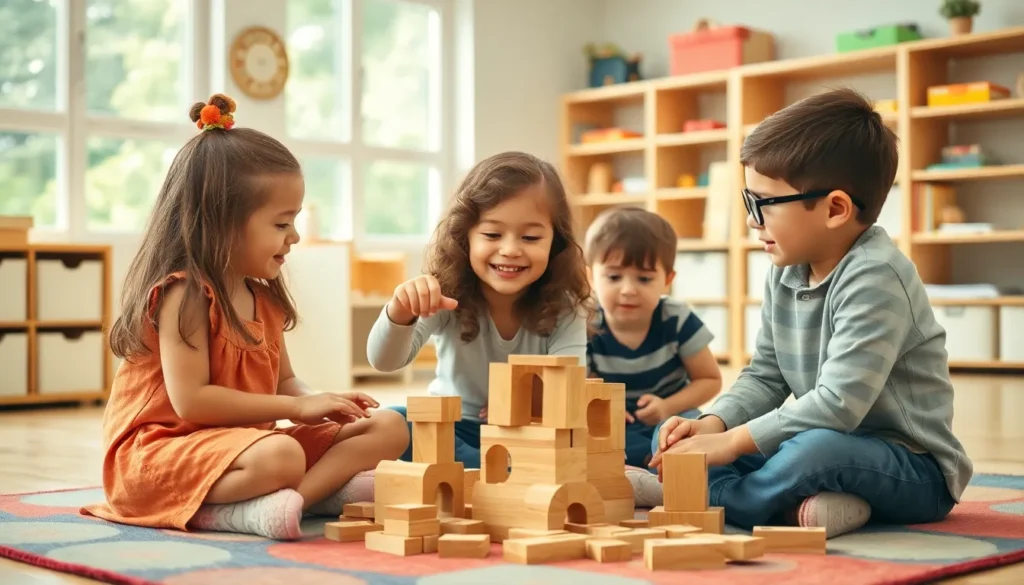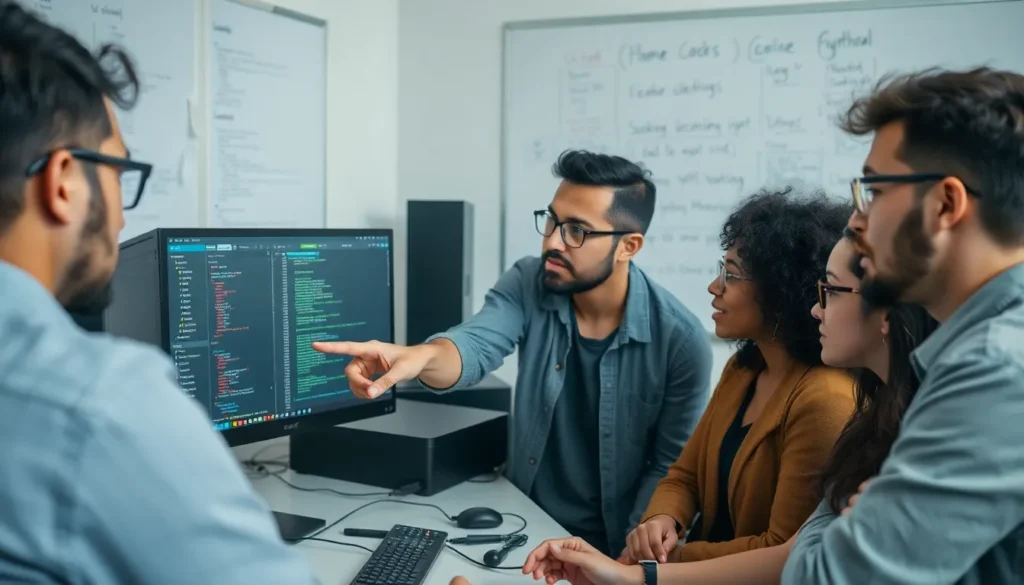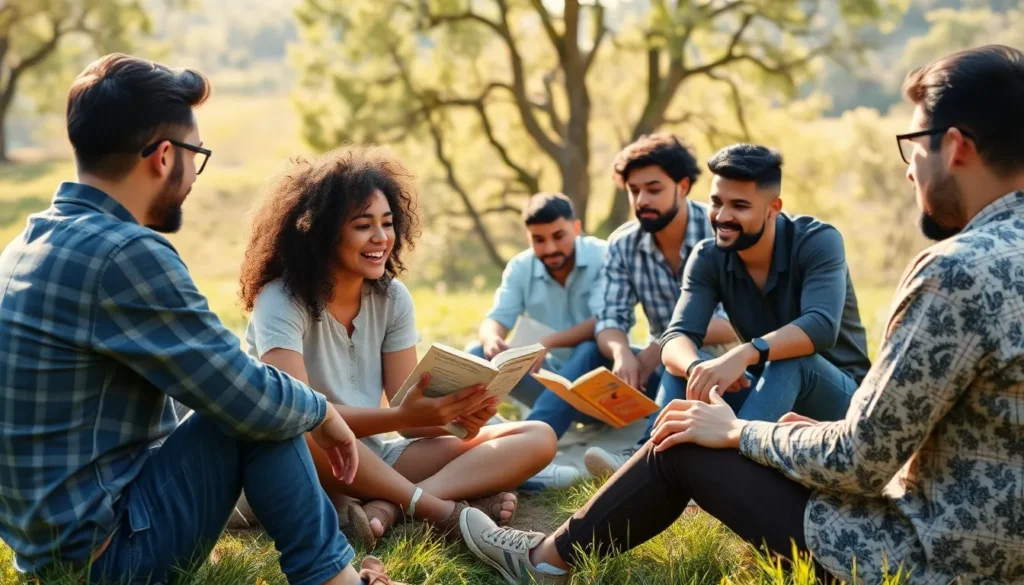Table of Contents
ToggleIn a world where problem-solving often feels like a high-stakes game of chess, Montessori education swoops in like a superhero, cape billowing in the wind. It’s not just about memorizing formulas or following rigid rules; it’s about fostering creativity and independence in children. Imagine a classroom where kids tackle challenges with the enthusiasm of a puppy chasing its tail—exciting, right?
Understanding Montessori Problem-Solving
Montessori problem-solving emphasizes exploration and critical thinking. This method nurtures a child’s innate curiosity and independence in finding solutions.
Definition and Principles
Montessori problem-solving encompasses a hands-on approach that allows children to engage with their environment. This process involves observing, experimenting, and reflecting. Active exploration fosters confidence in navigating challenges. Key principles include self-directed learning, collaboration, and respect for the child’s individual pace. These elements create an atmosphere where problem-solving becomes natural and instinctive. Children learn to ask questions, seek answers, and develop resilience. Overall, this approach promotes lifelong skills essential for personal and academic growth.
Importance in Education
Montessori problem-solving holds significant importance in contemporary education. This approach cultivates critical thinking skills necessary for real-world contexts. Children learn to approach challenges with creativity and persistence. Engaging in problem-solving enhances cognitive development and emotional intelligence simultaneously. Additional benefits include improved social skills through collaborative efforts. Education systems focused on this methodology observe increased engagement and motivation among students. Ultimately, Montessori problem-solving equips learners with vital tools for diversified learning experiences.
Techniques Used in Montessori Problem-Solving

Montessori problem-solving utilizes specific techniques that foster a child’s ability to navigate challenges independently and collaboratively.
Hands-On Learning
Hands-on learning forms the backbone of Montessori problem-solving. Children engage directly with materials that encourage exploration. They manipulate objects to understand abstract concepts, promoting cognitive connections. Each interaction with these materials cultivates critical thinking skills. For instance, using building blocks allows children to experiment with structures and balance, enhancing spatial awareness. The tactile experience solidifies learning, making it both effective and enjoyable. Observing how children figure out solutions through trial and error showcases their resilience. It empowers them to trust their instincts while tackling problems.
Collaborative Learning
Collaborative learning plays a significant role in Montessori problem-solving. Children often work together, sharing ideas and strategies. This approach fosters communication skills while cultivating a sense of community. When one child encounters a challenge, peers can offer insights and support. Such collaboration strengthens problem-solving abilities and builds social skills. For example, group projects encourage negotiation and compromise, vital tools for future interactions. Working alongside others enhances mutual respect, as children recognize diverse perspectives. This environment promotes an understanding that solutions often come from collective effort rather than individual endeavors.
Benefits of Montessori Problem-Solving
Montessori problem-solving offers numerous advantages, fostering essential skills that benefit children in various aspects of life.
Fosters Independence
Montessori problem-solving nurtures independence by encouraging children to take charge of their learning. Children engage in self-directed activities, which allows them to explore at their own pace. They develop decision-making skills, learning to choose their tools and methods for solving problems. Autonomy fosters a sense of ownership over the learning process, enhancing motivation and commitment. Moreover, when children encounter challenges, they learn to persist and find solutions without immediate adult intervention. This autonomy instills confidence, preparing them for future encounters with complex activities and decisions.
Enhances Critical Thinking
Critical thinking flourishes within the Montessori framework. Children actively participate in hands-on learning, which encourages exploration and experimentation. Engaging with materials stimulates curiosity, prompting children to ask questions and seek answers creatively. They connect concepts through practical experiences, allowing for deeper understanding. Collaborative activities further enhance critical thinking, as children share perspectives and negotiate solutions. Diverse viewpoints lead to richer discussions, promoting analytical skills. Ultimately, this approach develops their ability to assess situations thoughtfully and make informed decisions in real-life contexts.
Challenges in Implementing Montessori Problem-Solving
Implementing Montessori problem-solving often comes with specific challenges that educators and institutions face.
Resistance to Change
Resistance from staff members frequently occurs when transitioning to Montessori methods. Some educators may prefer traditional teaching styles, resulting in reluctance to adopt new practices. Training and professional development become crucial in overcoming this resistance. Institutions that invest in workshops and support systems facilitate smoother transitions. An understanding of Montessori principles increases comfort levels among staff. Communication about the benefits of this approach leads to greater buy-in from educators. Active involvement from leadership also plays a significant role in fostering a supportive environment for change.
Resource Limitations
Resource limitations can hinder the full implementation of Montessori problem-solving. Schools often face budget constraints that restrict access to specialized materials and training programs. Gathering sufficient Montessori materials, such as manipulatives and learning tools, is essential for effective instruction. Insufficient funding also affects classroom environments, making it difficult to create optimal learning spaces. Collaborative efforts might help mitigate these issues by pooling resources among local schools. Community partnerships and grants provide another avenue for obtaining necessary materials and funding. Improving resource allocation ensures that all children receive equitable opportunities for problem-solving experiences.
Montessori problem-solving stands as a powerful method for nurturing children’s natural curiosity and independence. By fostering an environment where exploration and collaboration thrive, it equips learners with essential skills for navigating real-world challenges. The hands-on and self-directed nature of this approach not only enhances cognitive development but also builds emotional intelligence and social skills.
As educators and parents embrace Montessori principles, they can create enriching experiences that prepare children for future success. Overcoming implementation challenges through professional development and community support will ensure that all children benefit from this transformative educational philosophy. Ultimately, Montessori problem-solving cultivates resilient and creative thinkers ready to tackle life’s complexities.






